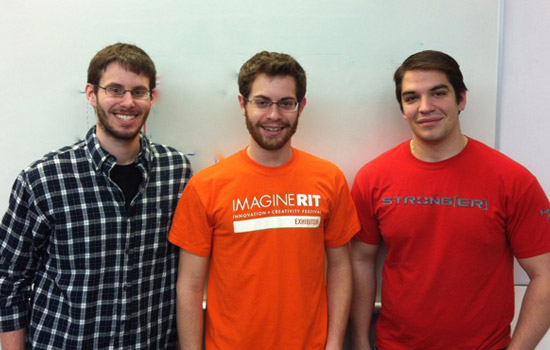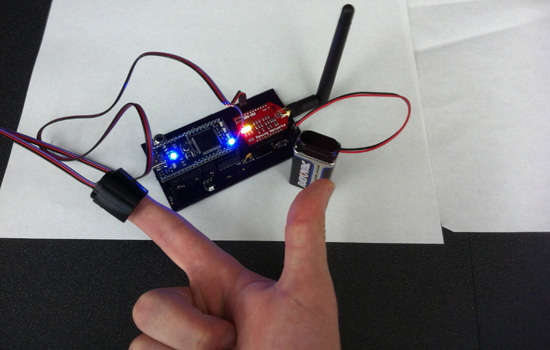Students develop heart monitoring system
Computer engineering students develop prototype for inexpensive heart monitor
The BioTelemetrix prototype heart monitor is a non-invasive heart monitoring system. The biomedical device uses a combination of microprocessors, wireless technology and sensors to monitor several patient physiological signals.
What began as a senior design project, motivated in part by personal loss, is taking on a new life as a lifesaving device.
When Nick Desaulniers’ father had a heart attack just over two years ago, he was expected to make a full recovery. However, a month later, while still in the hospital, he had another heart attack in his sleep. He was discovered about an hour afterward unresponsive.
His passing prompted Desaulniers to wonder: If the hospital had patient monitoring devices, might his father have survived?
Desaulniers, Cody Cziesler and Nick Sereni, all fifth-year computer engineering students in the Kate Gleason College of Engineering at Rochester Institute of Technology, developed BioTelemetrix, a prototype for a non-invasive heart monitoring system.
“I asked the doctors, how does something like that happen? A hundred dollars worth of parts for a monitor could have prevented this,” says Desaulniers. “Every patient should have monitoring equipment like they have a bed.”
In spring 2012, he and his team won the Xerox Corp. Award for the BioTelemetrix equipment at the RIT Imagine Innovation and Creativity Festival and placed third in the RIT Shark Tank, a business plan competition for student-entrepreneurs. This past fall, the students began extensive testing and seeking venture capital support for the BioTelemetrix technology, a new product they believe may be as useful to medical personnel as the families of individuals who need medical monitoring.
Patient monitoring equipment varies from high-tech hospital systems to medical alert bracelets patients must activate to connect with emergency personnel. Costs also vary with the equipment, and medical facilities install equipment in restricted areas such as intensive care units.
“We thought we could significantly bring down the cost of the monitoring equipment by using something like an inexpensive microprocessor, similar to the little tiny chip that you find in a cell phone,” says Desaulniers, from Bristol, Conn.
The microprocessor is the core technology and acquires physiological signals processed through sensors and wireless architecture. Anchored by a dedicated server capable of being accessed by multiple users, the system connects to a secure website to access, store and review data. The student-developers are also testing different encryption methods to further ensure patient privacy.
As they continue the development process, the students are looking beyond hardware and software to how they establish themselves as credible product developers. “Hospitals like to go with something that has already been tested,” says Cziesler, from Chittenango, N.Y. “We are working to prove that our system would work as well as existing systems. We think our architecture can scale well beyond anything a hospital would need. It is also modular, so we are able to add on software and components quickly.”
Beyond heart patients, the team believes the technology has multiple uses such as support for individuals and medical staff monitoring the elderly or newborn infants.
“A hospital wouldn’t need to be the only market for this device,” says Sereni, who is from Sanborton, N.H. “It’s closest competition might be the Life Alert bracelet, but this doesn’t do live monitoring, it just sends an alarm. Our product is like Life Alert on steroids.”
 Cody Cziesler, Nick Desaulniers and Nick Sereni, all fifth-year computer engineering students in the Kate Gleason College of Engineering, are the product designers behind BioTelemetrix, a non-invasive heart monitoring system.
Cody Cziesler, Nick Desaulniers and Nick Sereni, all fifth-year computer engineering students in the Kate Gleason College of Engineering, are the product designers behind BioTelemetrix, a non-invasive heart monitoring system.













